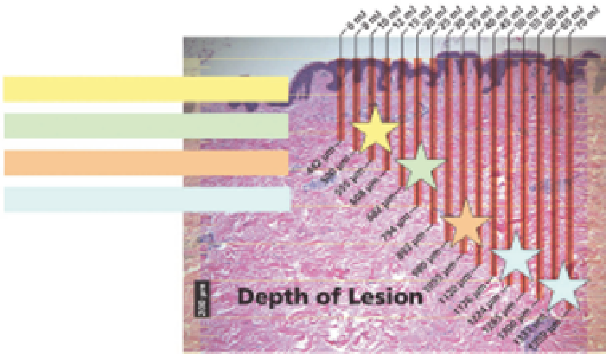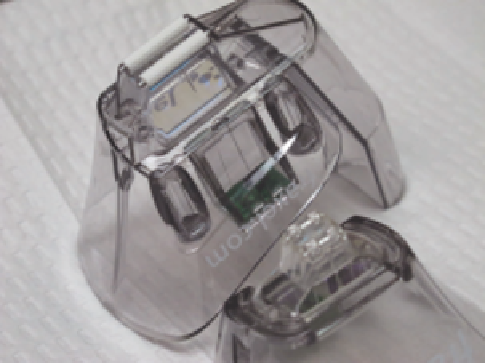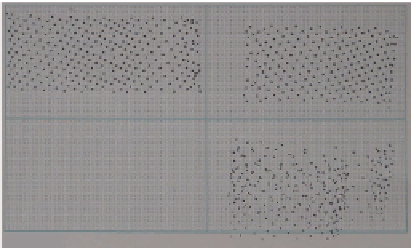Biomedical Engineering Reference
In-Depth Information
1550 nm wavelength
Pigment, tone/texture-superficial
Mild rhytids-mid-range
Moderate rhytids-mid-deep range
Acne scars and surgical scars-deep
Figure 8.4
Approximate depths of thermal impact by fluence.
the rolling technique may not be uniformly distributed. Some
pulses overlap while others are adjacent and some are farther
apart (Fig. 8.5B).
Fractional 1550-nm Laser
The Fraxel 1550-nm laser, which is the most extensively stud-
ied nonablative resurfacing laser, was introduced in 2006. It is
indicated for moderate skin damage resurfacing for periorbital
wrinkles, pigmented lesions, dyschromia, scars, melasma, and
actinic keratosis. It can deliver laser energy ranging from 4 to
70 mJ. Its TLs range from 5% to 48% coverage. Maximum
absorption depth into the skin is estimated to be 1400-1500 µm
deep. As discussed previously, different depths of the skin can
be treated for different indications and TLs can be adjusted to
determine the aggressiveness of treatment. For example, to
target a deep scar with the Fraxel 1550-nm laser, a higher
energy like 50-70 mJ will be selected. An example of an aggres-
sive TL will be 12 and cover 35% of the facial skin in one treat-
ment. In patients with darker skin types (Fitzpatrick types
IV-VI), the density must be delivered at a lower TL like 4-6 or
11-17% coverage to reduce the chances of post-infl ammatory
hyperpigmentation (PIH) (Table 8.1).
(
A
)
Fraxel Re:Store
®
laser pattern paper
1550 nm
1927 nm
20 mJ TL 7
10 mJ TL 7
1
2
Fractional 1550-nm and 1927-nm Lasers
Fraxel DUAL 1550/1927 (Solta Medical) was introduced in
October 2009. Both lasers are housed in the same platform and
function independently of each other. A fully 1550-nm treat-
ment or a fully 1927-nm treatment may be performed. The
lasers may also be used in combination with a different wave-
length used in different cosmetic units/body areas or both
lasers can be layered on top of each other for a combination
treatment. The thulium 1927-nm wavelength has a higher
absorption coeffi cient for water than the 1550-nm wavelength
so it has a greater ability to target the epidermis. See Figure 8.6
that illustrates the absorption of the two wavelengths. Energy
fl uences for the 1927-nm laser range from 5 to 20 mJ and the
TL ranges from 20% to 70% coverage. It has a maximum depth
of penetration of 200 µm into the skin. Therefore, this wave-
length is more effective in treating epidermal processes like
actinic keratoses. An average energy and TL for a patient with
a Fitzpatrick skin type (I-III) will be 10-20 mJ and a TL of 3-6
that corresponds to 30-45% coverage (Table 8.2). In 2011, the
3
4
40 mJ TL 7
20 mJ TL 7
(
B
)
Figure 8.5
(
A
) Tip for rolling device. This must be replaced approximately every
5-10 treatments. (
B
) Rolling patterns for rolling devices (1550 and 1927 nm).
handpieces should be positioned perpendicular to the skin
and it should not be lifted while the foot switch is depressed.
Handpiece velocity is also measured on the laser during treat-
ment. Passes should be smooth and controlled and stay within
the recommended velocity levels. If the treatment passes are
delivered too fast, the laser microdots become oval rather than
round and therefore the energy delivered may be reduced by
up to 50% which leads to undertreatment. Pulses delivered by


















